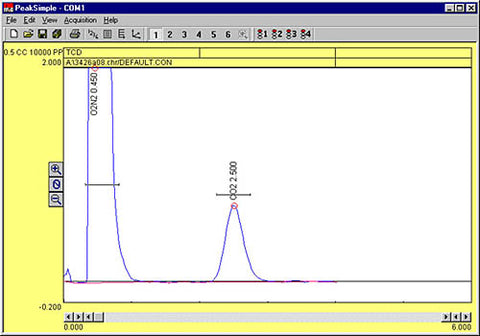Description
- Universal detector
- Detects from 100% down to 200-500 ppm
- Easily replaceable filaments
- Thermostatted up to 275° C
Because it detects all molecules, the Thermal Conductivity Detector is commonly used for fixed gas analysis (O2, N2, CO, CO2, H2S, NO, etc.) where the target analytes do not respond well on other, more sensitive detectors. The TCD can detect concentrations from 100% down to around 100 ppm on a flat baseline with sharp peaks. Where the peak is broad or the baseline is not flat, detection limits of 300 ppm are more realistic. For lower detection limits, the HID detector may be more suitable for inorganics, and the FID detector provides 1ppm detection for hydrocarbon species.

This chromatogram shows 0.5mL 10,000 ppm (1%) CO2 separated from
air using a 1-meter Silica Gel packed column at 80°C.
The TCD consists of four tungsten-rhenium filaments in a Wheatstone bridge configuration. Electric current flows through the filaments, causing them to heat up. Carrier gas (usually helium, which has very high thermal conductivity) flows across the filaments, removing heat at a constant rate. Two of the filaments are exposed only to carrier gas (reference), and two are exposed to the carrier/sample flow. When a sample molecule with lower thermal conductivity than the carrier gas exits the column and flows across the two sample filaments, the temperature of the filaments increases. This temperature increase unbalances the Wheatstone bridge and generates a peak as sample molecules transit through the detector.
A filament protection circuit prevents filament damage by disabling the current if carrier pressure is not detected by the GC, but cannot prevent filament damage in all circumstances. The TCD is equipped with user-replaceable filaments in the event of a burn-out.


